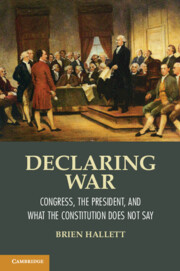Book contents
- Frontmatter
- Contents
- List of Figures
- Acknowledgments
- Prologue
- Miscellaneous Frontmatter
- 1 A Constitutional Tyranny and Presidential Dictatorship
- Part I What Is the History?
- Part II What Is a Declaration of War?
- Part III What Are the Solutions?
- Part IV What Is the Theory?
- Appendix I Five Congressional Declarations of War and One Appropriations Act
- Appendix II The Fœderative Powers in Parliamentary Governments
- References
- Index
Appendix II - The Fœderative Powers in Parliamentary Governments
Published online by Cambridge University Press: 05 November 2012
- Frontmatter
- Contents
- List of Figures
- Acknowledgments
- Prologue
- Miscellaneous Frontmatter
- 1 A Constitutional Tyranny and Presidential Dictatorship
- Part I What Is the History?
- Part II What Is a Declaration of War?
- Part III What Are the Solutions?
- Part IV What Is the Theory?
- Appendix I Five Congressional Declarations of War and One Appropriations Act
- Appendix II The Fœderative Powers in Parliamentary Governments
- References
- Index
Summary
To begin with the obvious, executive functions in a parliamentary regime are not vested in a single chief executive officer, a president, but in a cabinet. As a result, executive decision making is officially collective. A prime minister may dominate the cabinet, but, in theory, at least, no decision is a purely subjective mental act of a single chief executive officer, as in a presidential regime. All executive decisions result officially from collective discussions and processes. To anticipate, this means that a proto–Council on War and Peace already exists in a parliamentary regime. Equally important, the complex executive-legislative relationship in a parliamentary system is very much more organic and integrated than in a presidential-congressional system. A mechanical separation of these two functions is avoided. As a result, the apparent competition and conflict that characterize presidential regimes are largely absent.
Consider a parliament’s organic executive-legislative advantages first: As a large, majority-rule body, a parliament naturally suffers from all of the same problems as large, majority-rule congresses: 1) high transaction costs, 2) difficulty coordinating the members’ shared interests, and 3) exorbitant collective action problems. To overcome these inherent tensions, parliamentary regimes require the same firm agenda setting and leadership from the executive as congressional regimes. However, instead of trying to separate the executive from the legislative in a very abstract and artificial way with a single chief executive officer or president, parliamentary regimes fold the executive functions directly into the parliament. The majority party or coalition forms the cabinet. This means that executive functions are melded with legislative functions to produce a more seamless and stable form of government.
- Type
- Chapter
- Information
- Declaring WarCongress, the President, and What the Constitution Does Not Say, pp. 251 - 256Publisher: Cambridge University PressPrint publication year: 2012



